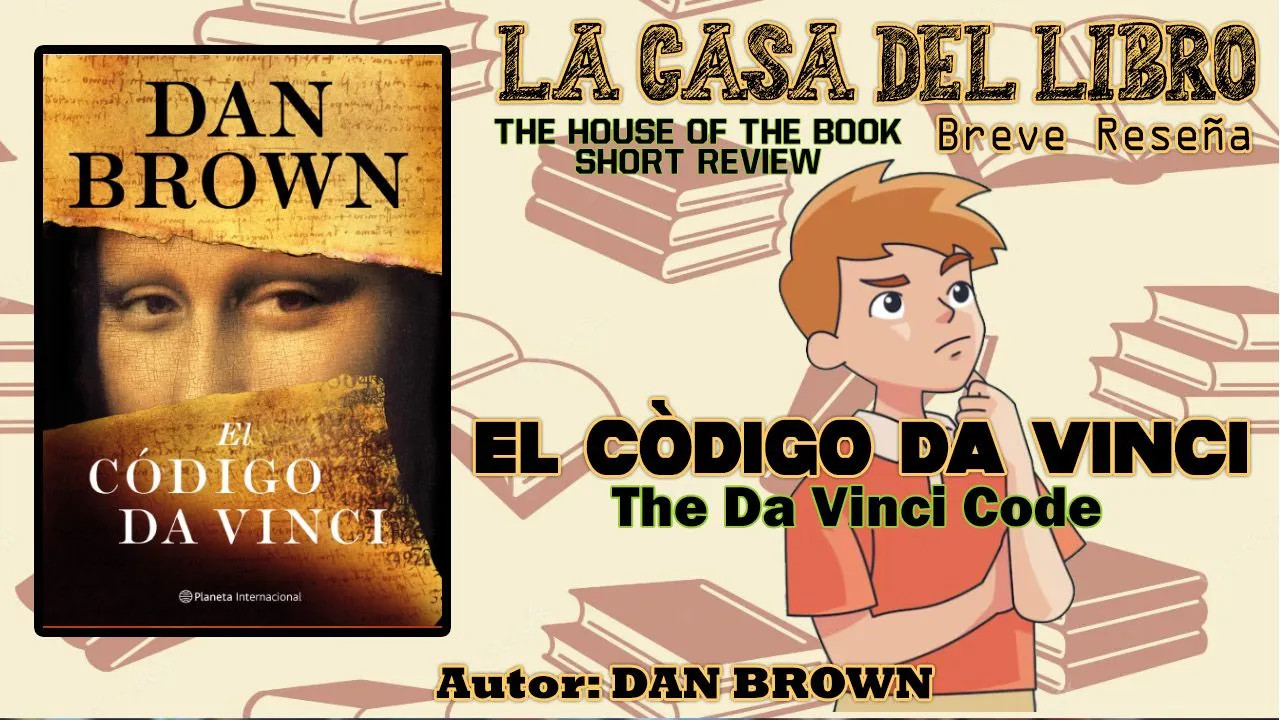

Amigos lectores, disculpen que no habia vuelto a publicar, estaba en cuestiones laborales, les dejo el siguiente libro de lo que es la saga de DAN BROWM, y seguire publicando la colecciòn de mis libros.

BREVE RESEÑA/BRIEF REVIEW.
El código Da Vinci es la obra más emblemática de Dan Brown y una de las novelas más leídas y debatidas del siglo XXI. La historia comienza con el asesinato de Jacques Saunière, curador del Museo del Louvre, en circunstancias misteriosas. Su muerte desencadena una serie de enigmas que lo conectan con una antigua sociedad secreta y con un secreto milenario que podría alterar la historia del cristianismo.
El protagonista, Robert Langdon, experto en simbología religiosa, es convocado por la policía francesa, pero pronto se ve envuelto como sospechoso. Junto a Sophie Neveu, criptóloga y nieta del fallecido, inicia una carrera frenética por descifrar los mensajes ocultos en las obras de Leonardo da Vinci y en otros artefactos históricos, los cuales los conducen por París, Londres y Escocia.
A medida que descifran las pistas, descubren una supuesta verdad escondida durante siglos: que el Santo Grial no es un objeto, sino una persona, y que esta revelación fue suprimida por instituciones religiosas para preservar su poder. El conflicto central de la obra gira en torno a la tensión entre la fe institucionalizada y las verdades históricas ocultas.
The Da Vinci Code is Dan Brown's most iconic work and one of the most widely read and debated novels of the 21st century. The story begins with the murder of Jacques Saunière, curator of the Louvre Museum, under mysterious circumstances. His death triggers a series of enigmas that connect him to an ancient secret society and a millennia-old secret that could alter the history of Christianity.
The protagonist, Robert Langdon, an expert in religious symbolism, is summoned by the French police, but soon finds himself embroiled as a suspect. Together with Sophie Neveu, a cryptologist and granddaughter of the deceased, he embarks on a frantic race to decipher the messages hidden in the works of Leonardo da Vinci and other historical artifacts, which lead them through Paris, London, and Scotland.
As they decipher the clues, they discover a supposed truth hidden for centuries: that the Holy Grail is not an object, but a person, and that this revelation was suppressed by religious institutions to preserve their power. The central conflict of the work revolves around the tension between institutionalized faith and hidden historical truths.



OPINIÒN PERSONAL/Personal Opinion.
El código Da Vinci es mucho más que un best seller de suspenso: es una novela que invita a reflexionar sobre el papel de la religión, el arte y el poder en la construcción de la historia. Dan Brown logra articular una trama intensa, con un ritmo implacable, sin descuidar la profundidad de los temas tratados.
El personaje de Langdon funciona como un guía intelectual, equilibrado y racional, mientras que Sophie aporta el componente emocional, personal y ético que le da humanidad al relato. Juntos construyen una dinámica que mantiene al lector comprometido durante toda la lectura.
Lo más fascinante de esta obra es cómo convierte al lector en un detective, enfrentándolo a símbolos, cifras y obras de arte que esconden significados más allá de su apariencia. El enfoque de Brown sobre temas como el rol de María Magdalena, el Opus Dei y el Priorato de Sion ha sido objeto de controversia, pero precisamente esa polémica ha contribuido a su resonancia cultural.
Si bien es una novela de ficción y debe leerse como tal, su valor reside en la manera en que desafía las narrativas oficiales y estimula la curiosidad histórica, haciendo de la lectura una experiencia activa, inquietante y emocionante.
The Da Vinci Code is much more than a best-selling thriller: it is a novel that invites reflection on the role of religion, art, and power in the construction of history. Dan Brown manages to articulate an intense plot with a relentless pace, without neglecting the depth of the topics covered.
The character of Langdon serves as an intellectual guide, balanced and rational, while Sophie provides the emotional, personal, and ethical component that gives the story its humanity. Together they create a dynamic that keeps the reader engaged throughout the book.
The most fascinating thing about this work is how it turns the reader into a detective, confronting them with symbols, numbers, and works of art that hide meanings beyond their appearance. Brown's approach to topics such as the role of Mary Magdalene, Opus Dei, and the Priory of Sion has been controversial, but it is precisely this controversy that has contributed to its cultural resonance.
Although it is a work of fiction and should be read as such, its value lies in the way it challenges official narratives and stimulates historical curiosity, making reading an active, unsettling, and exciting experience.

LA CASA DEL LIBRO

Un thriller brillante, provocador y culturalmente influyente. Una obra que marcó un antes y un después en la ficción contemporánea, y que continúa siendo relevante por su audacia y su capacidad de despertar preguntas incómodas.
A brilliant, provocative, and culturally influential thriller. A work that marked a turning point in contemporary fiction and continues to be relevant for its boldness and ability to raise uncomfortable questions.
